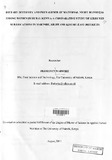| dc.description.abstract | Background: Although the prevalence of vitamin A deficiency in Kenya is estimated to be of
sustained public health significance, information is scanty on the same among cassava reliant
populations in Kenya who are targeted for the newly developed bio-fortified high beta-carotene
(yellow) cassava. Therefore, the current study sought to provide information on food consumption
and prevalence of vitamin A deficiency among selected cassava consuming populations in Kenya
for selection of appropriate study site for the yellow cassava bio-efficacy feeding trial by the
'Improving Nutrition through Staple Foods in Africa' Project.
Materials and Methods: Three cross sectional surveys were conducted between July and
October, 2009 among mothers in Kai, Junju and Wathorogo sub-locations purposively selected
within Makindu, Kilifi and Kisumu -East Districts of Kenya respectively. Focus group
discussions with mothers aged 17 to 85 years old, key informant interviews with administrative
leaders, health workers and school head teachers, and case studies were used to establish local
terms and descriptions for night blindness. Thereafter, a history of maternal night-blindness was
elicited from mothers for their recent live birth within the previous three years to the survey. A
total of 290 mothers consisting of 94, 83, and 113 women in Kai, Junju and Wathorego sub-locations
respectively were interviewed. In addition, qualitative 24 hour recall individual dietary
diversity questionnaire (21 food group) was administered to all the 290 mothers. Both the crude
and adjusted prevalence rates of maternal night blindness were computed and populations with
5% crude prevalence of maternal night blindness were considered to have vitamin A deficiency
problem of public health significance as recommend by the International Vitamin A Consultative
Group. Comparison of study variables for significant differences across the sub-locations was
done at both individual and population levels and a 0.05 level of significance was used.
Relationships among dietary diversity, maternal night blindness and socio-economic
characteristics were also analysed in SPSS 17.
Results: The mean age of mothers interviewed was 25.8 years with an average of three children
per mother and a mean duration of 15 months since last birth. Majority of them were lactating
(73.4%), had attained primary education (61.3%) and mainly housewives (39.0%). A total of 28
mothers (9.7%) reported to have experienced night blindness during their last pregnancy that
ended in a live birth. About16% of these mothers were from Kai, 9.5% from Junju and 4.4% from
Wathorego corresponding to the crude prevalence rates of maternal night blindness. On
adjustment, the prevalence of maternal night blindness reduced to 12.2%, 6.5% and 1.9% for Kai,
Junju and Wathorego respectively. Both the crude and adjusted prevalence rates of maternal nightblindness
were significantly different across the sub-locations. The mean dietary diversity scores
were highest in Wathorego at 5.43 ± 0.24; followed by Junju with 4.63 ±0.34 and least in Kai at
3.88 ± 0.36 at the 95% confidence interval. Likewise, the proportions of mothers who had
consumed vitamin A rich foods within the previous 24 hrs were significantly different across the
sub-locations with Wathorego leading at 95.6%; followed by Junju (80.7%) and least in Kai
(57.4%). Both maternal night blindness and dietary diversity scores for mothers were significantly
associated with age of the mother, number of children by mother and number of children attending
primary school from the household.
Conclusions: Vitamin A deficiency is of public health significance in both Kai and Junju sublocations
(2: 5% crude prevalence of maternal night blindness). Kai sub-location has the highest
prevalence of vitamin A deficiency' and least dietary diversity among mothers. Thus, this study
recommends Kai sub-location as a suitable study site for the yellow cassava feeding trial | en |

